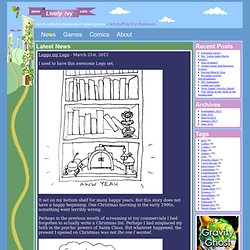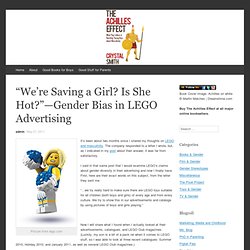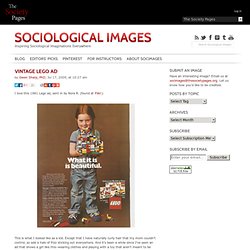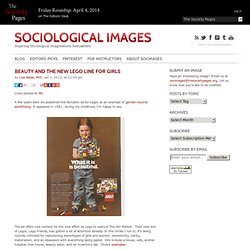

Breaking News: LEGO Fails Girls (Again) Oh LEGO.

You’ve gone and done it again. In April 2012 representatives from your company met with SPARK. After that meeting I had such hope that there would be change in your approach to toy design. The Little Girl from the 1981 LEGO Ad is All Grown Up, and She’s Got Something to Say. **A Women You Should Know Exclusive** By Lori Day – In mid-January, this article on The Huffington Post hit my Facebook newsfeed like a Justin Bieber deportation petition—it was everywhere.

In it, HuffPost Family News Editor Jessica Samakow writes: Pay attention, 2014 Mad Men: This little girl is holding a LEGO set. The LEGOs are not pink or “made for girls.” She isn’t even wearing pink. Something about this piece with the iconic 1981 ad tapped the zeitgeist and it became one of HuffPo’s more viral articles in recent memory, receiving over 60,000 shares. As I was planning my interview with Rachel Giordano, I saw this blog post by Achilles Effect, and knew immediately what Giordano should be holding in the new version of the photo. “Break the big story of the world’s best cake with the Heartlake News Van! Cake? As Achilles Effect blogger Crystal Smith notes, “This toy had so much potential to inspire young girls who think journalism would be a cool career. Gendering LEGO. On a friend’s Facebook wall the other day, the topic of geek girls needing to defend their geekiness came up, and the topic shifted to gendered LEGO sets.

Even having had this conversation many times, I noticed something on the LEGO site that I hadn’t previously. Go look at just the Bricks & More sets. Look at whether the “themed sets” and “starter sets” include male or female minifigures, or both. Male Minifigures Only: Lively Ivy » Blog Archive » Leggo my Lego. Leggo my Lego - March 21st, 2012 I used to have this awesome Lego set.

It sat on my bottom shelf for many happy years. But this story does not have a happy beginning. One Christmas morning in the early 1990s, something went terribly wrong. Perhaps in the previous month of screaming at toy commercials I had forgotten to actually write a Christmas list. Www.toutalego.com/2013/03/gender-marketing-lego-friends-ecoute-la.html. Why LEGO Friends is not the Worst Toy of 2012. It's been about a year since the LEGO Friends sets were first unveiled to the world at large, sparking a wide-ranging conversation about role of gender in construction toys.

After a relatively quiet summer and fall, this topic recently resurfaced with the announcement that the Campaign for a Commercial-Free Childhood had chosen the LEGO Friends Butterfly Beauty Shop as a semi-finalist for the annual TOADY, a Worst Toy of the Year un-award (it ended up coming in second place). KJ Dell'Antonia has already done a great job of unpacking some of the reasons the Butterfly Beauty Shop set should not be singled as one of the five worst toys of the year, but I want to go one step further and prove that there are quantitatively worse toys on the market.
Let's start with a side by side comparison of the Butterfly Beauty Shop with the Mega Bloks Barbie Build 'n Style Fashion Boutique. Much to my surprise, Friends came in second (Halo was highest) with a ratio of 9.8. The Minidolls. LEGO Friends: A Case for Gender-Neutral Marketing. As much as we try not to make birthdays about presents, there is no getting around the excitement that birthday gifts bring.

Case in point, my son, who recently turned six, threw his hands over his head and shouted “Yes!” When he opened his “big” gift. What was inside? The LEGO Friends Adventure Camper: I’ve written several times about LEGO Friends, most recently in a post where I describe my mixed feelings about the toys—stereotyped for girls, but a good toy for boys who want a different kind of LEGO experience, i.e. not just cops & robbers, construction, superheroes, weapon-wielding Ninjas, or Star Wars. “We’re Saving a Girl? Is She Hot?”—Gender Bias in LEGO Advertising. Picture from lego.com It’s been about two months since I shared my thoughts on LEGO and masculinity.

The company responded to a letter I wrote, but, as I indicated in my post about their answer, it was far from satisfactory. Vintage Lego Ad. I love this 1981 Lego ad, sent in by Nora R.

(found at Flikr): This is what I looked like as a kid. Except that I have naturally curly hair that my mom couldn’t control, so add a halo of frizz sticking out everywhere. LEGO et les filles. Le géant LEGO s’intéresse (ou plutôt, se réintéresse) au marché féminin et compte proposer en 2012 une nouvelle gamme d’ensembles de construction spécialement pour les filles (source: Le Figaro, via Fabien Deglise sur G+)… La nouvelle gamme s’appellera LEGO Friends, et on peut déjà voir la boîte des différents ensembles sur The Brick Blogger, un blogue consacré aux LEGO.

Bien sûr, on en voulait, des blocs roses! LEGO proposait déjà deux boîtes avec des projets génériques, mais du rose dans des ensembles plus élaborés, ça ne peut qu’être apprécié. ;-) Et côté thématiques, il y a de belles idées qui ont été développées pour LEGO Friends, comme une inventeuse dans son garage ultra girly, un vétérinaire, un joli café, une maison dans un arbre… Beauty and the New Lego Line For Girls. Cross-posted at Ms.

A few years back we published this fantastic ad for Legos as an example of gender-neutral advertising. It appeared in 1981; during my childhood, I’m happy to say. The ad offers nice context for the new effort by Lego to capture The Girl Market. Their new line of Legos, Lego Friends, has gotten a lot of attention already. In the circles I run in, it’s being roundly criticized for reproducing stereotypes of girls and women: domesticity, vanity, materialism, and an obsession with everything being pastel. Remettre chacun.e à sa place. Beaucoup d’articles ont été écrits, ces dernières semaines, à propos de la nouvelle gamme Lego Friends.
Si vous ne l’avez pas encore vue, attention, ça pique les yeux. Ah, oui, et c’est une gamme pour filles. Why My Daughters Won’t be Playing with Lego Friends. The internet has been abuzz regarding the new Lego Friends line. I am in the anti-Friends camp, and after engaging in a lot of discussion with real-life human friends, I’ve figured out why I feel so strongly. I’ve rounded up the 5 most common questions about the issue and done my best to address each one: 1. Are these toys really that different from other Legos? Aren’t these kits equally challenging? The figures are very different: Considering that 4 of the 5 new minifigs are wearing skirts, and are all thinner with breasts, well, you can do your own analysis of the message being sent about female-ness. As for complexity, this depends on how you compare. Another Blast from Lego’s Past: Gender-Neutral Vintage Ads. By Lisa Wade, PhD, Jul 29, 2012, at 03:28 pm A while back readers absolutely fell in love with a vintage Lego ad from 1981, featuring a red-headed befreckled girl in pigtails and overalls.
It, and two more in the series, reminded us that advertising doesn’t have to impose rigid gender stereotypes the way that most advertising today and the newest Lego marketing strategy certainly does. Joanne M. dug up two more examples, both from Family Circle in 1978. Feast your eyes on these happy children: David Pickett, by the way, wrote us an amazing four part history of Lego’s (failed) efforts — or lack thereof — to reach out to girls. Lego Friends : le problème des Lego « pour filles » La marque danoise Lego a lancé début 2012 une gamme pensée exclusivement pour les filles, et a récolté en guise de réactions un gros paquet de sourcils froncés. Tilda Elisabeth vous explique pourquoi. Flashback des fêtes. Part I: Historical Perspective on the LEGO Gender Gap. The splashy introduction of the new LEGO friends line earlier this year stirred up a lot of controversy.
My goal with this set of posts is to provide some historical perspective for the valid concerns raised in this heated debate. 1932-1977: The Brick Era The LEGO Group started as a family business with the motto “only the best is good enough.” The company produced primarily wooden toys for the first two decades of its existence. It wasn’t until 1958 that the iconic LEGO brick was patented as we know it today. In the 70s we encounter the first LEGO theme marketed specifically at girls: Homemaker. Dolls are popular toys, so finding ways to integrate the LEGO experience into this existing model of play was a shrewd business strategy for TLG, but one that nevertheless perpetuated stereotypes. The 70s also saw TLG experimenting with different types of human-like figures. 1978-1988: The Golden Era.
Part II: Historical Perspective on the LEGO Gender Gap. The splashy introduction of the new LEGO friends line earlier this year stirred up a lot of controversy. My goal with this set of posts is to provide some historical perspective for the valid concerns raised in this heated debate. 1989-2003: Gender Ahoy! I discussed the introduction of LEGOs the invention of gendered minifigs, and early efforts to market separately to girls and boys in Part I of this series, covering 1932 to 1988. The segregation of LEGO into feminine and masculine sets would escalate beginning in 1989. Part III: Historical Perspective on the LEGO Gender Gap. The splashy introduction of the new LEGO friends line earlier this year stirred up a lot of controversy. My goal with this set of posts is to provide some historical perspective for the valid concerns raised in this heated debate.
Part IV: Historical Perspective on the LEGO Gender Gap. The splashy introduction of the new LEGO friends line earlier this year stirred up a lot of controversy. My goal with this set of posts is to provide some historical perspective for the valid concerns raised in this heated debate. This is Part IV, see also: 2012: LEGO Friends and the Ensuing Backlash In Parts I through III, I’ve discussed the history of LEGO’s attempts to capture (or abandon) the imagination of girls and boys. In this final installment, I discuss their newest effort to market to girls, LEGO Friends. Several weeks before the first wave of LEGO Friends sets were available in U.S. retail stores, Bloomberg Businessweek ran a cover story that presented an in-depth look at TLG’s thought process in creating the sets.
This move implies that they foresaw the backlash this line would inspire and hoped to mitigate it.